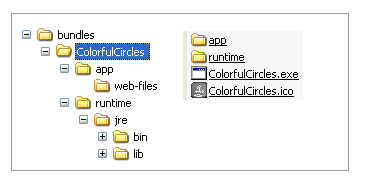
JPackageScriptFXThis project demonstrates how projects can use scripts to build self-contained, platform-specific executables andinstallers of their JavaFX applications via the jdeps, jlink, and jpackage tools. Two scripts are included forrunning builds on Mac and Windows. The jpackage tool is bundled with the JDK since version 14.Important: the scripts do not try to create a fully modularized solution but instead try to enable existingprojects / applications, which often use non-modularized 3rd party dependencies, to be packaged again after theprevious packaging tool stopped working since Java 11. Prerequisites. Any OpenJDK 14 Installation.
JavaFX packaging tools provide built-in support for several formats of self-contained application packages. The basic package is simply a single folder on your hard drive that includes all application resources as well as Java Runtime. It can be redistributed as is, or you can build an installable package (for example, EXE or DMG format). The Java Packager tool compiles, packages, and prepares Java and JavaFX applications for distribution. The javapackager command is the command-line version. For available Ant tasks, see JavaFX Ant Tasks in Java Platform, Standard Edition Deployment Guide. For self-contained applications, the Java Packager for JDK 9 packages applications with a JDK 9 runtime image generated by the.
On Windows you need to have the WIX toolset installed EnvironmentBoth platform-specific build scripts need to know where they can find the java installation with the jpackage tool.Therefore you have to set the environment variable JAVAHOME. How you set it dependson your operating system. On Mac you can set it inside the.bashprofiles file in your user home directory. On Windowsyou would set it in the 'environment variables' dialog.
In your IDE you can normally also set it as part of aMaven run configuration. If you are the only one working on the project then you can even add it to the pom.xml file ofthe main module. Project StructureThe project in this repository uses a multi-module Maven setup with a parent module containing three child modules.One of these child modules is the 'main' module as it contains the main class. This module also contains the buildscripts and its target directory will contain the results of the build.
The JavaFX application consists of a singlewindow displaying three labels. The first one shows the currently configured locale and the other two labels getimported from module 1 and module 2 respectively.Launcher ClassUpon closer inspection you will notice that the scripts are not creating packages and executables for App (whichextends the standard JavaFX Application class) but for AppLauncher. When an Application class gets launched thenJavaFX will check whether the JavaFX modules are present on the module path. But since we are placing them on theclasspath the application can not launch. As a work-around we are starting a standard Java class with a main method init. This prevents the module path check and the application will launch just fine without us having to provide any ofthe module system specific options.
IconsExecutables require an application icon. Default icons are part of the project. Feel free to use it for yourdevelopment efforts but make sure to replace it with your own before shipping your product.
The platform-specificicons can be found inside jpackagefx-main/src/main/logo. Building the ProjectOnce your environment is set up you can simply call the mvn clean install on the root / parent module. It will doa standard build of the application and in addition it will analyze all the dependencies and copy the resulting set ofJAR files into the folder target/libs.
This work is done via the Maven dependency plugin. Once the standard build iscompleted Maven will invoke the shell script (on Mac) or the batch script (on Windows). The build script uses twodifferent profiles, both of them being activated via the OS that they are running on.The scripts both have the same structure:. Environment. Dependency Analysis. Runtime Image Generation.
PackagingEnvironmentThe required environment for the scripts consists of environment variables and a directory structure. The followingvariables are used:. JAVAHOME - the location of the JDK matching the Java version.
JAVAVERSION - defines the runtime environment that the final application is targeting. PROJECTVERSION - the version of the project as defined in the pom.xml file (e.g.
1. Nvivo 10 crack for windows. 0-SNAPSHOT). APPVERSION - the version for the executable (careful: do not re-use project version. The supported Windows versionnumber format has to be major.minor.build, e.g.
Mac seems to be more flexible.). MAINJAR - the name of the jar file that contains the main classThe directory structure required by the build:. target/java-runtime - contains the runtime environment generated by jlink as part of the build. target/installer - contains the executables generated by jpackage as part of the build. target/installer/input/libs - contains the jars required by the application to runDependency AnalysisThe scripts use the jdeps tool to analyze the dependencies of the application to determine which modules need tobe included in the final package.

These modules are stored in the list detectedmodules.